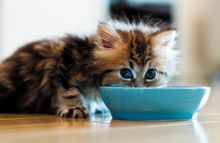3 cant-miss updates in feline veterinary nutrition
New research may lead to changes in feline diets, the benefits of food puzzles and more from Dr. Tony Buffington.
As it becomes ever-more apparent that many cat owners aren't getting the message about feline nutrition (58 percent of cats are overweight, according to pet obesity studies), Tony Buffington, DVM, MS, PhD, DACVN, recently spoke with dvm360 about new developments that can guide cat owners who visit your veterinary practice.
1. Protein and lean muscle mass. One study challenges popular belief, suggesting that cats need more protein than previously thought to sustain their lean muscle mass rather than just balance nitrogen levels, says Buffington, who recently retired from Ohio State University's Department of Veterinary Clinical Sciences. Buffington says this new knowledge could inspire changes in the way feline diets are formulated.

Photo source: Getty Images2. Food puzzles. Feeding management is an area that should be studied in greater depth, Buffington says. He loves using food puzzles-they provide mental and physical stimulation for cats all day long as the cats work to get the puzzles' rewards.
“I work in a large urban practice, and essentially I'm a zoo veterinarian, because all of our animals are captive indoors,” Buffington says. “As we've learned from the zoo vets, feeding enrichment is one of the best forms of environmental enrichment the animals under our care can have.”
3. Maximizing kitten visits. Emphasizing nutrition with clients early and educating them to recognize different body types can help prevent pet obesity, Buffington says. “I'm personally dismayed that we don't seem to be making a whole lot of progress on obesity in adult animals,” he says. “One option I'd like to see explored more is to teach body condition scoring to owners of kittens. As any behaviorist will tell you, it's a whole lot easier to shape behaviors than it is to change behaviors.”
Capitalizing on a new client's early round of visits is integral to building long-term success, Buffington says. “Those first three appointments that we have-what are sometimes called ‘routine vaccination appointments'-in my view are the three most important interactions we'll ever have with that client and that cat,” he says. “They shape the relationship we're going to have for the rest of the time we interact with each other. And that's our opportunity to shape it in the best interest for the long-term health and welfare of both the cat and the client.”